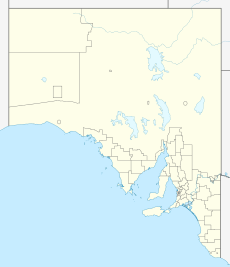Glen Roy Conservation Park facts for kids
Quick facts for kids Glen Roy Conservation ParkSouth Australia |
|
|---|---|
|
IUCN Category III (Natural Monument)
|
|
| Nearest town or city | Penola |
| Established | 12 November 1970 |
| Area | 544 hectares (1,340 acres) |
| Visitation | ‘low’ (in 1990) |
| Managing authorities | Department for Environment and Water |
| See also | Protected areas of South Australia |
Glen Roy Conservation Park is a special protected area in South Australia. It's about 323 kilometers (200 miles) southeast of Adelaide, the state capital. You can find it around 25 kilometers (15 miles) north of the town of Penola. This park helps protect important plants and animals in the region.
The park covers an area of 544 hectares (about 1,344 acres). It is managed by the Department for Environment and Water.
Contents
History of the Park
How the Park Was Created
The park was first created on November 12, 1970. Back then, it was called Glen Roy National Park. It became a protected area under a law called the National Parks Act 1966.
Name Change to Conservation Park
A couple of years later, on April 27, 1972, the park's name changed. It became Glen Roy Conservation Park. This happened when a new law, the National Parks and Wildlife Act 1972, was introduced. This new law replaced older ones about protecting nature.
Why the Park is Important
In 1980, Glen Roy Conservation Park was listed on something called the Register of the National Estate. This meant it was recognized as a very important place. It was described as a "remnant of open forest and seasonal swampland." This means it's a small piece of a natural area that shows a lot of different plants and habitats. It also provides a home for many animal species found in southeastern South Australia.
What the Park Looks Like
In 1990, experts described the park as having three main types of areas, each with its own unique plants.
Hilly Forest Areas
Most of the park has gentle hills made of a type of rock called calcarenite. These hills are covered with reddish, sandy soils. Here, you'll find open forests with trees like brown stringybark and pink gum. There are also areas with loose sand that have brown stringybark trees.
Wet Western Woodlands
The western part of the park sometimes gets flooded. In these wetter areas, you can find woodlands with river red gum trees. These trees are well-suited to living in places that get wet often.
Eastern Swamps
In the eastern part of the park, there are swamps between the sand dunes. These swamps have dark, organic soils that sit on top of clay or marl. Here, you'll see dense areas of Leptospermum juniperinum (a type of tea-tree) and different kinds of sedges, which are grass-like plants.
Animals in the Park
As of 1990, several interesting animal species were seen living in Glen Roy Conservation Park. These included:
- the red-tailed black cockatoo, a large and striking bird
- the Yellow-footed antechinus, a small marsupial
- the common wombat, a sturdy burrowing animal
Park Visitors
In 1990, the number of people visiting the park was described as "low." Most of these visitors were "field naturalists." These are people who enjoy studying nature in its natural environment.
Park Protection Status
Glen Roy Conservation Park is classified as an IUCN Category III protected area. This means it's recognized internationally as a "Natural Monument or Feature." These areas are protected because they have unique natural features or specific natural habitats.


